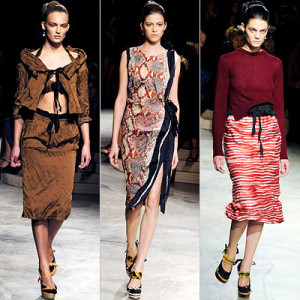The Changing World of Italian Fashion
Posted on October 11th, 2013 by Anna in Uncategorized | No Comments »
To many, the country of Italy is synonymous with fashion. In Italian culture, dressing up to draw attention to oneself and present “la bella figura,” or good impression, is a key aspect of social life. Taking meticulous care of one’s appearance has an almost religious importance, and in the evenings in Italy you’ll see men and women impeccably dressed up, with complementary shoes and accessories, to take on the night. Rome and Milan are widely considered to be two of the five great fashion capitals of the world, and names like Prada, Armani, Gucci, and Versace represent the pinnacle of excellence in this area, blending the line between clothing and high art since their inception.
Possibly the most high-profile name of leather accessories, luggage, and perfume, is Prada. Founded in 1913 as a shop for leather goods and steam trunks, it has mushroomed into a universally-recognized logo for high-end designer handbags. While their image has evolved over the years through various working class stages meant to appeal to the average consumer, today they embrace their role as a producer of luxury products. Armani, on the other hand, the fashion house of luxury suits, shoes, accessories, and cosmetics, has branded itself as a high-end label from the very beginning. Their imagination and innovation in the realm of haute couture (they designed an entire line of men’s suits woven entirely out of alpaca wool!) has made them one of the leading fashion brands in terms of influence and desirability.
Gucci, on the other hand, has taken a radical approach to its role in the fashion world. Founded in Florence by Guccio Gucci in 1921, Gucci has evolved to become one of the most distinctive names of high-end designer goods. In Florence, there is actually a Gucci Museum, open year-round, dedicated to serving as a permanent showcase for the fashions and designer items created under the brand. While many are applauding this daring move, it remains highly controversial in the message it delivers about the fashion world. By taking these high-end, extremely stylized costumes off of the runway and placing them in a public setting where anyone can access them (for an admission fee of €6,) it gives Gucci a more egalitarian image. While this provides Gucci more exposure in a wider arena than they would have had otherwise, it creates a distance between their past standards of luxury, uniqueness, and what some would call elitism.
Whatever changes are in store for Gucci and other Italian brands, the unprecedented move to incorporate fashion into art exhibitions seems to be catching on with other brands, such as Chanel and Steve McQueen. While purists may grumble, this is also introducing high fashion to a whole new generation of consumers, instilling new life into the old brands. And as high fashion’s relationship with the public continues to change, it’s the brands like Gucci, with a strong fan base but daring enough to branch out into new directions, that will continue to last into the new century.






